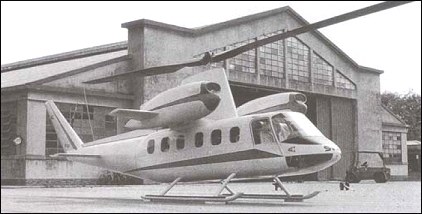
| SIAI-Marchetti SV-20 1970 - project |  |
 |

| SIAI-Marchetti SV-20 1970 - project |  |
 |
|
Societe Italiana Aeroplani Idrovolanti-Marchetti, based in Sesto Calende, Varese, in northern Italy, was founded in 1915, and developed its first helicopter, the SH-4, in cooperation with Silvercraft in 1965. As a result of the seeming success of the SH-4, SIAI-Marchetti’s Sezione Volo Verticale (Vertical Flight Division) was formed in 1968 under the leadership of Dr. Emilio Bianchi. SV-20C In July of that year, development began of the SV-20A (A = Alato or "winged") – a 14-seat twin-engine, winged, high-speed helicopter – as well as the SV-20C (C = "compound") – an improved performance version with a pusher propeller. The SV-20 was an ambitious project to design a helicopter that weighed 4,000kg when carrying a load greater than its empty weight and cruised at 390km/h. In December 1968, fabrication of dynamic components and major dynamic assemblies, as well as a number of airframes, was begun (first flight was originally expected in 1970). A full-scale mock-up of the SV-20A was also completed and was shown at the Paris Air Show. By the end of 1972, about 200,000 manhours had been spent on the SV-20 design, including wind tunnel testing at the Universities of Turin, Milan, and Pisa, but a prototype was not completed. The SIAI-Marchetti SV-20 had a two-blade teetering-hub main rotor, anti-torque rotor and a high mounted cantilever wing. The SV-20C compound added a three-blade variable pitch pusher propeller driven by the right engine. The two United Aircraft of Canada PT6C engines would have been built under license by Motoren-und-Turbinen-Union (the successor to MAN) in Germany. Each engine had a maximum rating of 900hp, and were located in two nacelles on the wing; the Turbomeca Astazou XIVA or Rolls-Royce RS.360 were considered as alternates based on customer preferences. The cabin was designed to transport 12 passengers or 1250kg of cargo in addition to the two pilots. The SV-20C was projected to be about 80kg heavier than the SV- 20A, but about 110km/h faster. Data given below are as of mid 1970; empty and maximum weight reached 2,420kg and 4,536kg respectively, by 1972. The wings of the SV-20 had movable surfaces acting as flaps or ailerons, allowing the pilot to vary the load between the rotor and the wing. During high speed flight, the rotor was to be partially unloaded by the wing and the surfaces were used to augment roll control. A version with a "Fenestron" type tail rotor was planned in 1970. Larger versions, such as 20 seat models of both compound and conventional helicopters, were envisioned. SIAI-Marchetti had plans to design a compound helicopter capable of 460km/h by 1975 and a stowed-rotor compound capable of 920km/h by 1980. Production jigs reportedly had produced numerous examples of many components by the end of 1972. A market of 500 units was expected, producing 40-60 SV-20s per year. Three prototypes were planned, but, despite initial talks with the FAA and the Registro Aeronautico Italiano (RAI) in January 1972, none of the prototypes were ever completed and the project was abandoned the following year. Agusta, which had acquired 30% of SIAI-Marchetti in 1970, had increased its stake to about 60% by 1973 and reached complete ownership in 1983.
| |||||||

|
|
 |